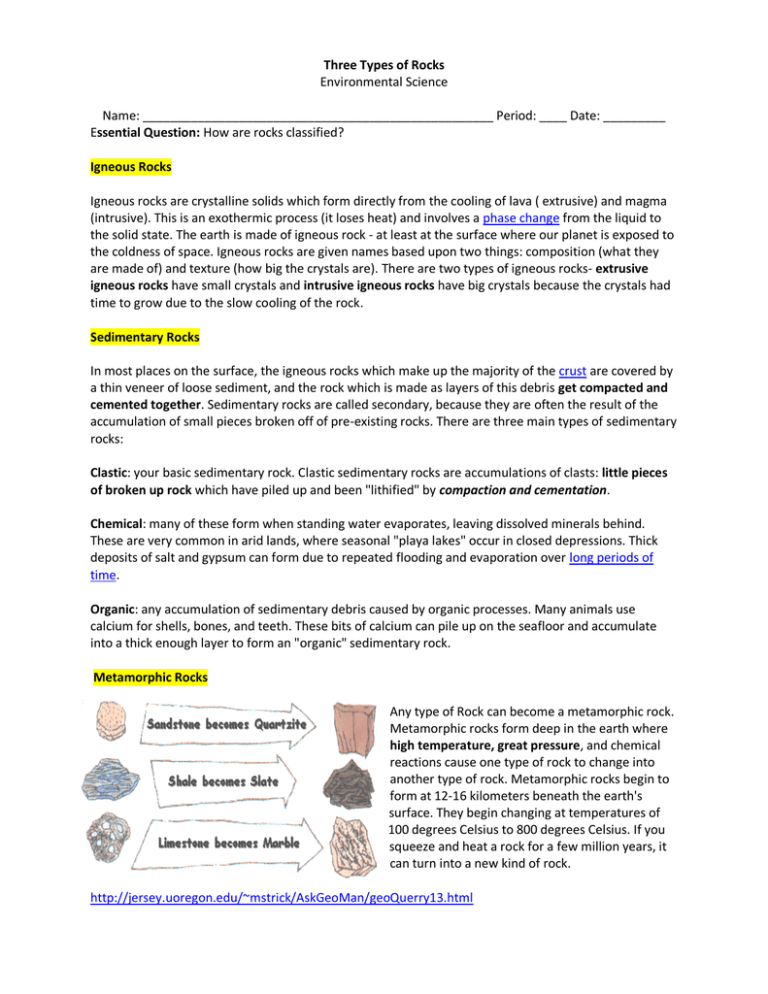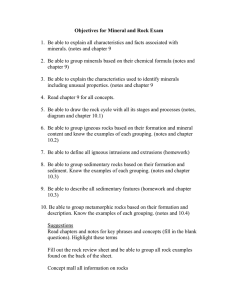Three Types of Rocks Environmental Science Name: Period: ____
advertisement

Three Types of Rocks Environmental Science Name: ___________________________________________________ Period: ____ Date: _________ Essential Question: How are rocks classified? Igneous Rocks Igneous rocks are crystalline solids which form directly from the cooling of lava ( extrusive) and magma (intrusive). This is an exothermic process (it loses heat) and involves a phase change from the liquid to the solid state. The earth is made of igneous rock - at least at the surface where our planet is exposed to the coldness of space. Igneous rocks are given names based upon two things: composition (what they are made of) and texture (how big the crystals are). There are two types of igneous rocks- extrusive igneous rocks have small crystals and intrusive igneous rocks have big crystals because the crystals had time to grow due to the slow cooling of the rock. Sedimentary Rocks In most places on the surface, the igneous rocks which make up the majority of the crust are covered by a thin veneer of loose sediment, and the rock which is made as layers of this debris get compacted and cemented together. Sedimentary rocks are called secondary, because they are often the result of the accumulation of small pieces broken off of pre-existing rocks. There are three main types of sedimentary rocks: Clastic: your basic sedimentary rock. Clastic sedimentary rocks are accumulations of clasts: little pieces of broken up rock which have piled up and been "lithified" by compaction and cementation. Chemical: many of these form when standing water evaporates, leaving dissolved minerals behind. These are very common in arid lands, where seasonal "playa lakes" occur in closed depressions. Thick deposits of salt and gypsum can form due to repeated flooding and evaporation over long periods of time. Organic: any accumulation of sedimentary debris caused by organic processes. Many animals use calcium for shells, bones, and teeth. These bits of calcium can pile up on the seafloor and accumulate into a thick enough layer to form an "organic" sedimentary rock. Metamorphic Rocks Any type of Rock can become a metamorphic rock. Metamorphic rocks form deep in the earth where high temperature, great pressure, and chemical reactions cause one type of rock to change into another type of rock. Metamorphic rocks begin to form at 12-16 kilometers beneath the earth's surface. They begin changing at temperatures of 100 degrees Celsius to 800 degrees Celsius. If you squeeze and heat a rock for a few million years, it can turn into a new kind of rock. http://jersey.uoregon.edu/~mstrick/AskGeoMan/geoQuerry13.html Clarifying Questions: 1. What are the three basic types of rocks? ______________________________________________________________________________ ______________________________________________________________________________ 2. How do igneous rocks form? ______________________________________________________________________________ ______________________________________________________________________________ 3. What does it mean by exothermic process? Think! ______________________________________________________________________________ ______________________________________________________________________________ 4. What is the surface of the Earth made of? ______________________________________________________________________________ ______________________________________________________________________________ 5. How are igneous rock named? ______________________________________________________________________________ ______________________________________________________________________________ 6. How do sedimentary rocks form? ______________________________________________________________________________ ______________________________________________________________________________ 7. How are extrusive igneous rocks different from intrusive igneous rocks? ______________________________________________________________________________ ______________________________________________________________________________ 8. Why are sedimentary rocks called secondary? ______________________________________________________________________________ ______________________________________________________________________________ 9. What are the three types of sedimentary rocks? ______________________________________________________________________________ ______________________________________________________________________________ 10. How do clastic rocks, a type of sedimentary rock, form? ______________________________________________________________________________ ______________________________________________________________________________ 11. What kind of sedimentary rock is one with shell? ______________________________________________________________________________ 12. What kind of rock can become a metamorphic rock? ______________________________________________________________________________ ______________________________________________________________________________ 13. How do metamorphic rocks form? ______________________________________________________________________________ ______________________________________________________________________________ Metamorphism – rocks change due to extreme heat and pressure. Sedimentary rock sandstone 15. limestone Metamorphic rock 14. slate 16.


